(PDF) Issues in financial accounting
VerifiedAdded on 2021/01/02
|11
|2516
|362
AI Summary
Contribute Materials
Your contribution can guide someone’s learning journey. Share your
documents today.

FINANCIAL ACCOUNTING
AND REPORTING
AND REPORTING
Secure Best Marks with AI Grader
Need help grading? Try our AI Grader for instant feedback on your assignments.
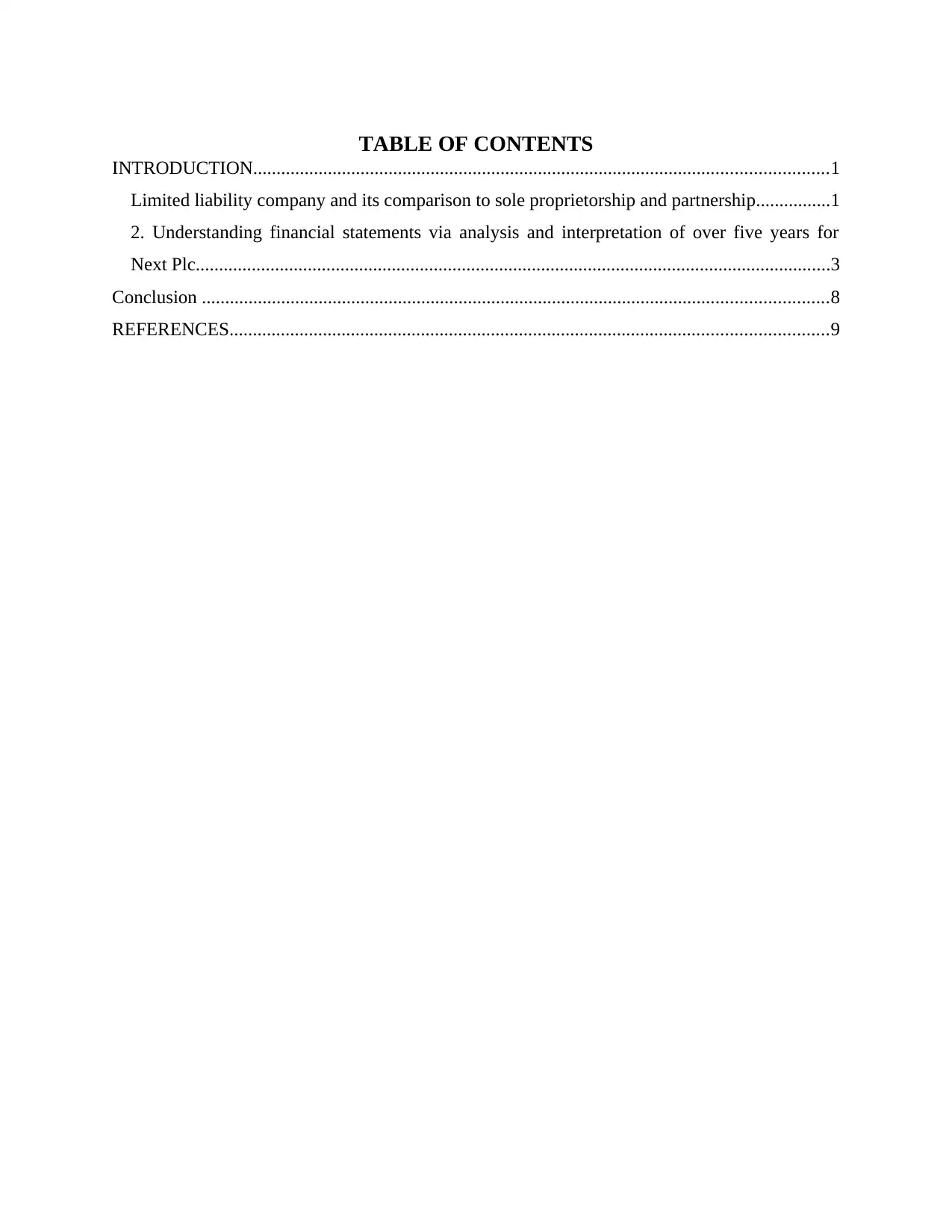
TABLE OF CONTENTS
INTRODUCTION...........................................................................................................................1
Limited liability company and its comparison to sole proprietorship and partnership................1
2. Understanding financial statements via analysis and interpretation of over five years for
Next Plc........................................................................................................................................3
Conclusion ......................................................................................................................................8
REFERENCES................................................................................................................................9
INTRODUCTION...........................................................................................................................1
Limited liability company and its comparison to sole proprietorship and partnership................1
2. Understanding financial statements via analysis and interpretation of over five years for
Next Plc........................................................................................................................................3
Conclusion ......................................................................................................................................8
REFERENCES................................................................................................................................9
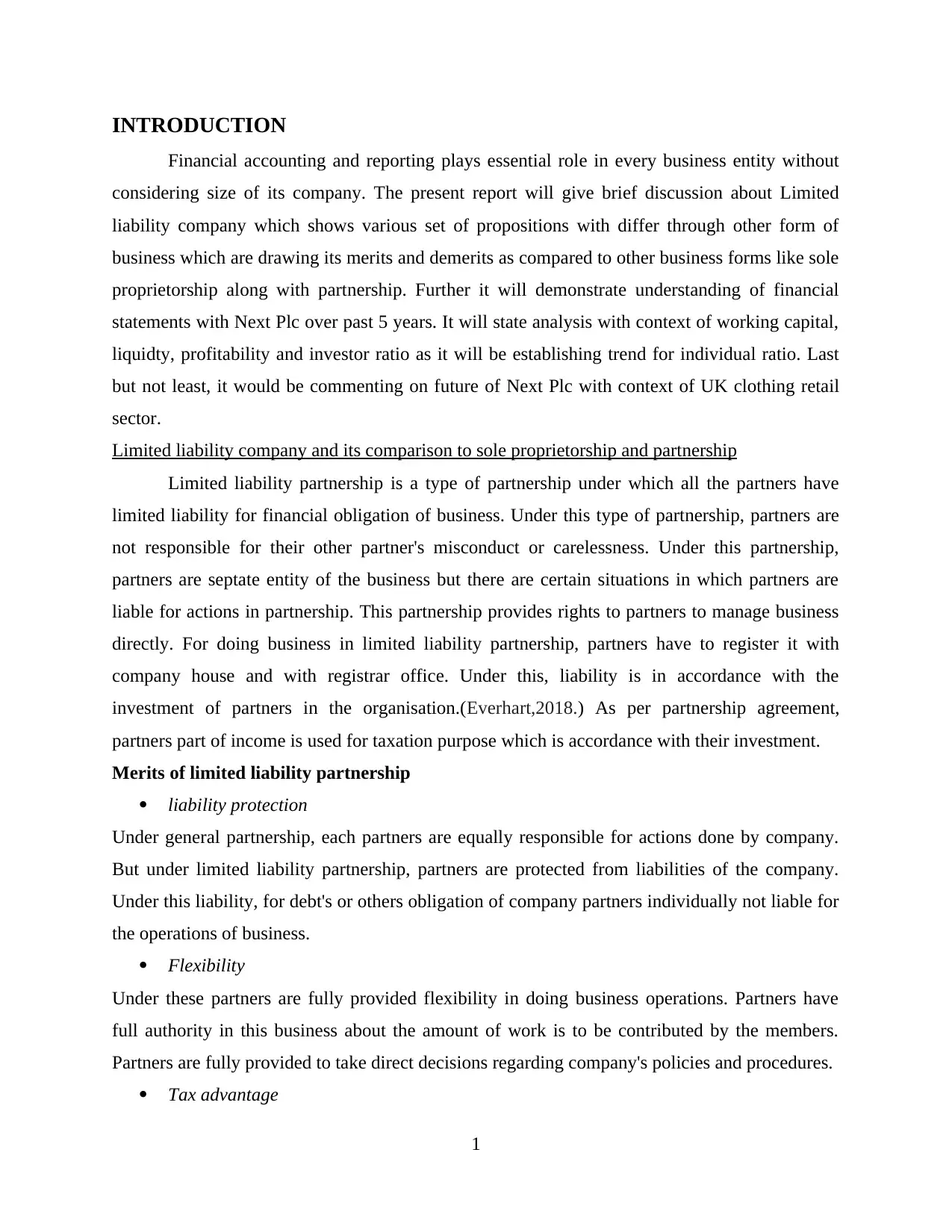
INTRODUCTION
Financial accounting and reporting plays essential role in every business entity without
considering size of its company. The present report will give brief discussion about Limited
liability company which shows various set of propositions with differ through other form of
business which are drawing its merits and demerits as compared to other business forms like sole
proprietorship along with partnership. Further it will demonstrate understanding of financial
statements with Next Plc over past 5 years. It will state analysis with context of working capital,
liquidty, profitability and investor ratio as it will be establishing trend for individual ratio. Last
but not least, it would be commenting on future of Next Plc with context of UK clothing retail
sector.
Limited liability company and its comparison to sole proprietorship and partnership
Limited liability partnership is a type of partnership under which all the partners have
limited liability for financial obligation of business. Under this type of partnership, partners are
not responsible for their other partner's misconduct or carelessness. Under this partnership,
partners are septate entity of the business but there are certain situations in which partners are
liable for actions in partnership. This partnership provides rights to partners to manage business
directly. For doing business in limited liability partnership, partners have to register it with
company house and with registrar office. Under this, liability is in accordance with the
investment of partners in the organisation.(Everhart,2018.) As per partnership agreement,
partners part of income is used for taxation purpose which is accordance with their investment.
Merits of limited liability partnership
liability protection
Under general partnership, each partners are equally responsible for actions done by company.
But under limited liability partnership, partners are protected from liabilities of the company.
Under this liability, for debt's or others obligation of company partners individually not liable for
the operations of business.
Flexibility
Under these partners are fully provided flexibility in doing business operations. Partners have
full authority in this business about the amount of work is to be contributed by the members.
Partners are fully provided to take direct decisions regarding company's policies and procedures.
Tax advantage
1
Financial accounting and reporting plays essential role in every business entity without
considering size of its company. The present report will give brief discussion about Limited
liability company which shows various set of propositions with differ through other form of
business which are drawing its merits and demerits as compared to other business forms like sole
proprietorship along with partnership. Further it will demonstrate understanding of financial
statements with Next Plc over past 5 years. It will state analysis with context of working capital,
liquidty, profitability and investor ratio as it will be establishing trend for individual ratio. Last
but not least, it would be commenting on future of Next Plc with context of UK clothing retail
sector.
Limited liability company and its comparison to sole proprietorship and partnership
Limited liability partnership is a type of partnership under which all the partners have
limited liability for financial obligation of business. Under this type of partnership, partners are
not responsible for their other partner's misconduct or carelessness. Under this partnership,
partners are septate entity of the business but there are certain situations in which partners are
liable for actions in partnership. This partnership provides rights to partners to manage business
directly. For doing business in limited liability partnership, partners have to register it with
company house and with registrar office. Under this, liability is in accordance with the
investment of partners in the organisation.(Everhart,2018.) As per partnership agreement,
partners part of income is used for taxation purpose which is accordance with their investment.
Merits of limited liability partnership
liability protection
Under general partnership, each partners are equally responsible for actions done by company.
But under limited liability partnership, partners are protected from liabilities of the company.
Under this liability, for debt's or others obligation of company partners individually not liable for
the operations of business.
Flexibility
Under these partners are fully provided flexibility in doing business operations. Partners have
full authority in this business about the amount of work is to be contributed by the members.
Partners are fully provided to take direct decisions regarding company's policies and procedures.
Tax advantage
1

Under general partnership individual have to file their overall company's taxation procedure but
under limited liability all the partnership members are not responsible to pay tax. Under this
individual credits are provided according to their interest in the company which will prove
beneficial to them.
Demerits of limited liability partnership
public disclosure
Under limited liability partnership, partners have to disclose all their reports and accounts in
public. Financial accounts of the company is to be submitted to companies house and also
income of member is to be disclosed by the partners.
Rights of partners
Under this partnership structured is formed in such a way that individual partners have right to
take company's decision by which others may not feel comfortable to work which affect
company and business will not run positive direction.(Munro, 2017.)
Comparison of sole proprietorship and partnership with limited liability partnership
Sole proprietorship partnership Limited liability
partnership
ownership Generally ownership
remains in the hands
of sole trader.
Under this ownership
provided as per the
agreement of
partnership.
Under this ownership
is provided as per the
partnership agreement.
liability Under this, liability is
in hands of sole trader
and is personally liable
for the debts of the
partnership.
Each partner is
personally liable for
the debt of the
partnership.
Under this, liability is
in accordance with the
investment of partners
in the organisation.
taxation Individual has to
provide part of income
in taxation purpose.
As per partnership
agreement part of
income from profit is
to be provided by
partners for taxation
In this, also as per
partnership agreement,
partners part of
income is used for
taxation purpose
2
under limited liability all the partnership members are not responsible to pay tax. Under this
individual credits are provided according to their interest in the company which will prove
beneficial to them.
Demerits of limited liability partnership
public disclosure
Under limited liability partnership, partners have to disclose all their reports and accounts in
public. Financial accounts of the company is to be submitted to companies house and also
income of member is to be disclosed by the partners.
Rights of partners
Under this partnership structured is formed in such a way that individual partners have right to
take company's decision by which others may not feel comfortable to work which affect
company and business will not run positive direction.(Munro, 2017.)
Comparison of sole proprietorship and partnership with limited liability partnership
Sole proprietorship partnership Limited liability
partnership
ownership Generally ownership
remains in the hands
of sole trader.
Under this ownership
provided as per the
agreement of
partnership.
Under this ownership
is provided as per the
partnership agreement.
liability Under this, liability is
in hands of sole trader
and is personally liable
for the debts of the
partnership.
Each partner is
personally liable for
the debt of the
partnership.
Under this, liability is
in accordance with the
investment of partners
in the organisation.
taxation Individual has to
provide part of income
in taxation purpose.
As per partnership
agreement part of
income from profit is
to be provided by
partners for taxation
In this, also as per
partnership agreement,
partners part of
income is used for
taxation purpose
2
Paraphrase This Document
Need a fresh take? Get an instant paraphrase of this document with our AI Paraphraser
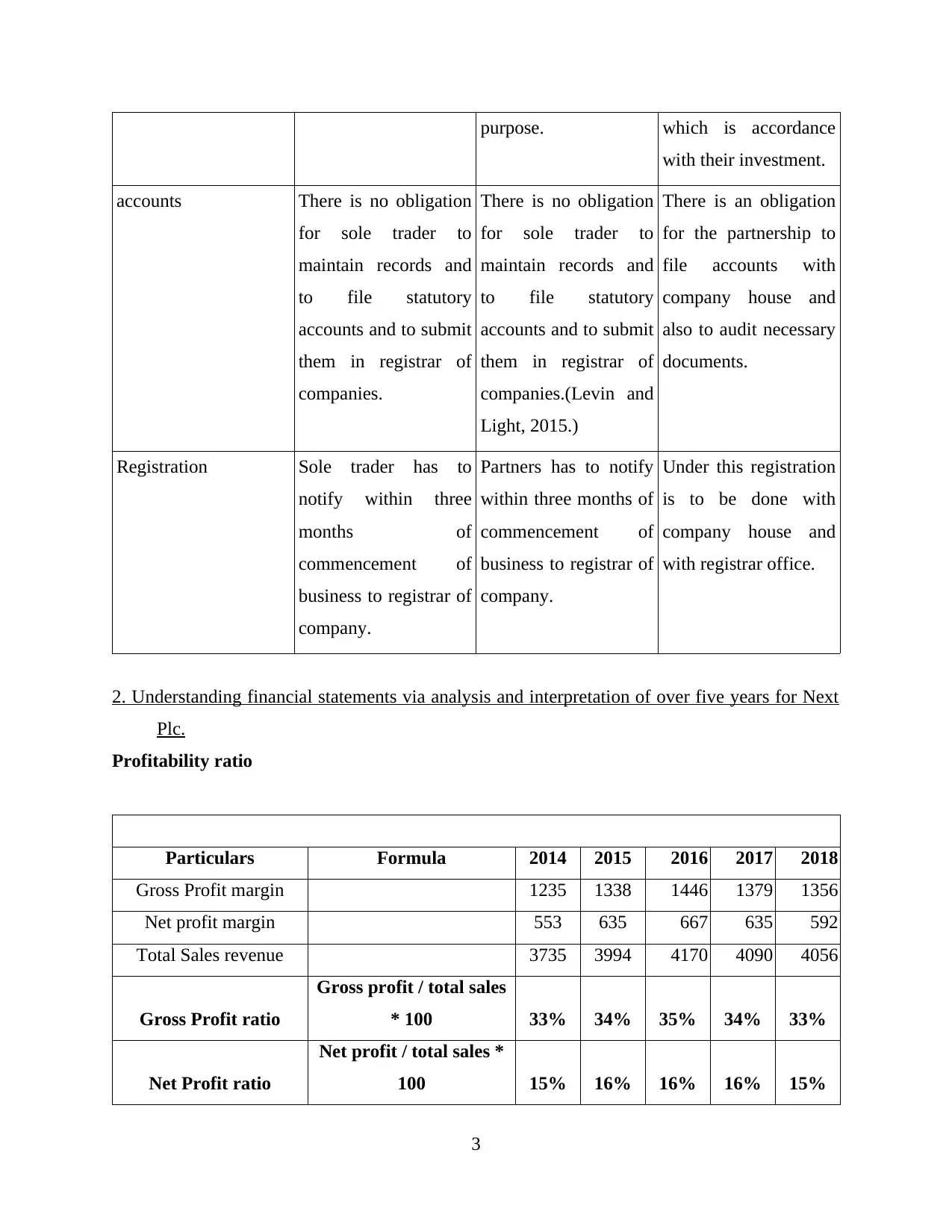
purpose. which is accordance
with their investment.
accounts There is no obligation
for sole trader to
maintain records and
to file statutory
accounts and to submit
them in registrar of
companies.
There is no obligation
for sole trader to
maintain records and
to file statutory
accounts and to submit
them in registrar of
companies.(Levin and
Light, 2015.)
There is an obligation
for the partnership to
file accounts with
company house and
also to audit necessary
documents.
Registration Sole trader has to
notify within three
months of
commencement of
business to registrar of
company.
Partners has to notify
within three months of
commencement of
business to registrar of
company.
Under this registration
is to be done with
company house and
with registrar office.
2. Understanding financial statements via analysis and interpretation of over five years for Next
Plc.
Profitability ratio
Particulars Formula 2014 2015 2016 2017 2018
Gross Profit margin 1235 1338 1446 1379 1356
Net profit margin 553 635 667 635 592
Total Sales revenue 3735 3994 4170 4090 4056
Gross Profit ratio
Gross profit / total sales
* 100 33% 34% 35% 34% 33%
Net Profit ratio
Net profit / total sales *
100 15% 16% 16% 16% 15%
3
with their investment.
accounts There is no obligation
for sole trader to
maintain records and
to file statutory
accounts and to submit
them in registrar of
companies.
There is no obligation
for sole trader to
maintain records and
to file statutory
accounts and to submit
them in registrar of
companies.(Levin and
Light, 2015.)
There is an obligation
for the partnership to
file accounts with
company house and
also to audit necessary
documents.
Registration Sole trader has to
notify within three
months of
commencement of
business to registrar of
company.
Partners has to notify
within three months of
commencement of
business to registrar of
company.
Under this registration
is to be done with
company house and
with registrar office.
2. Understanding financial statements via analysis and interpretation of over five years for Next
Plc.
Profitability ratio
Particulars Formula 2014 2015 2016 2017 2018
Gross Profit margin 1235 1338 1446 1379 1356
Net profit margin 553 635 667 635 592
Total Sales revenue 3735 3994 4170 4090 4056
Gross Profit ratio
Gross profit / total sales
* 100 33% 34% 35% 34% 33%
Net Profit ratio
Net profit / total sales *
100 15% 16% 16% 16% 15%
3
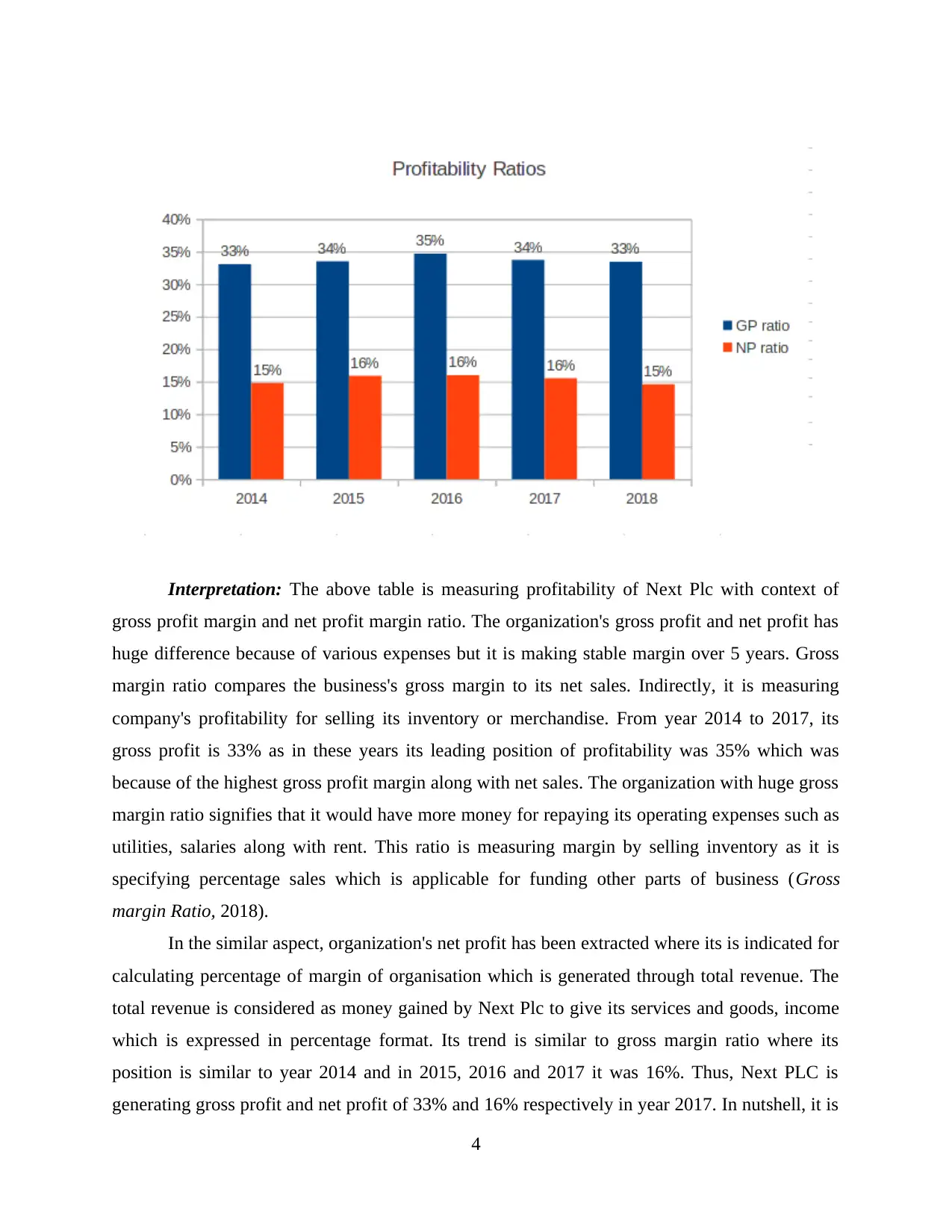
Interpretation: The above table is measuring profitability of Next Plc with context of
gross profit margin and net profit margin ratio. The organization's gross profit and net profit has
huge difference because of various expenses but it is making stable margin over 5 years. Gross
margin ratio compares the business's gross margin to its net sales. Indirectly, it is measuring
company's profitability for selling its inventory or merchandise. From year 2014 to 2017, its
gross profit is 33% as in these years its leading position of profitability was 35% which was
because of the highest gross profit margin along with net sales. The organization with huge gross
margin ratio signifies that it would have more money for repaying its operating expenses such as
utilities, salaries along with rent. This ratio is measuring margin by selling inventory as it is
specifying percentage sales which is applicable for funding other parts of business (Gross
margin Ratio, 2018).
In the similar aspect, organization's net profit has been extracted where its is indicated for
calculating percentage of margin of organisation which is generated through total revenue. The
total revenue is considered as money gained by Next Plc to give its services and goods, income
which is expressed in percentage format. Its trend is similar to gross margin ratio where its
position is similar to year 2014 and in 2015, 2016 and 2017 it was 16%. Thus, Next PLC is
generating gross profit and net profit of 33% and 16% respectively in year 2017. In nutshell, it is
4
gross profit margin and net profit margin ratio. The organization's gross profit and net profit has
huge difference because of various expenses but it is making stable margin over 5 years. Gross
margin ratio compares the business's gross margin to its net sales. Indirectly, it is measuring
company's profitability for selling its inventory or merchandise. From year 2014 to 2017, its
gross profit is 33% as in these years its leading position of profitability was 35% which was
because of the highest gross profit margin along with net sales. The organization with huge gross
margin ratio signifies that it would have more money for repaying its operating expenses such as
utilities, salaries along with rent. This ratio is measuring margin by selling inventory as it is
specifying percentage sales which is applicable for funding other parts of business (Gross
margin Ratio, 2018).
In the similar aspect, organization's net profit has been extracted where its is indicated for
calculating percentage of margin of organisation which is generated through total revenue. The
total revenue is considered as money gained by Next Plc to give its services and goods, income
which is expressed in percentage format. Its trend is similar to gross margin ratio where its
position is similar to year 2014 and in 2015, 2016 and 2017 it was 16%. Thus, Next PLC is
generating gross profit and net profit of 33% and 16% respectively in year 2017. In nutshell, it is
4
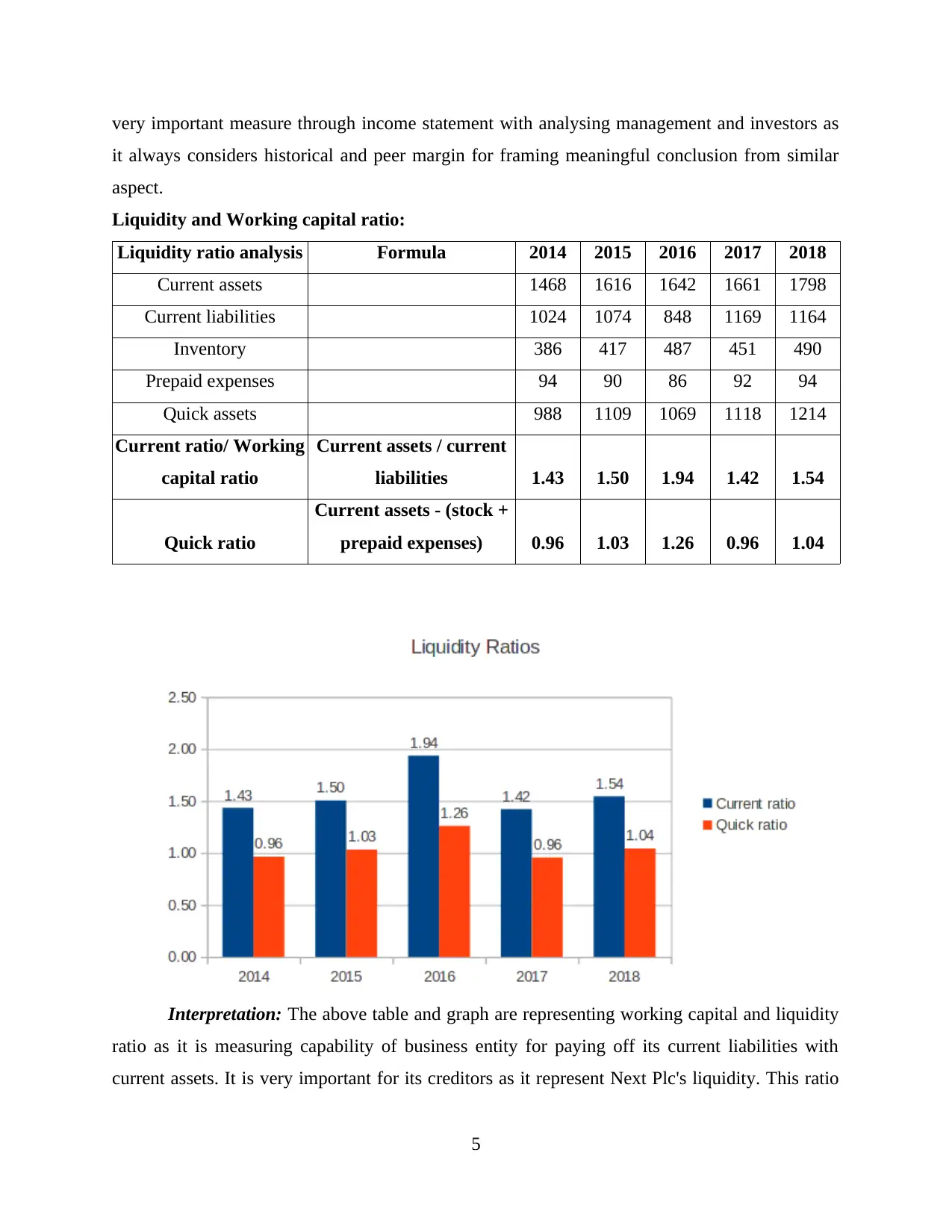
very important measure through income statement with analysing management and investors as
it always considers historical and peer margin for framing meaningful conclusion from similar
aspect.
Liquidity and Working capital ratio:
Liquidity ratio analysis Formula 2014 2015 2016 2017 2018
Current assets 1468 1616 1642 1661 1798
Current liabilities 1024 1074 848 1169 1164
Inventory 386 417 487 451 490
Prepaid expenses 94 90 86 92 94
Quick assets 988 1109 1069 1118 1214
Current ratio/ Working
capital ratio
Current assets / current
liabilities 1.43 1.50 1.94 1.42 1.54
Quick ratio
Current assets - (stock +
prepaid expenses) 0.96 1.03 1.26 0.96 1.04
Interpretation: The above table and graph are representing working capital and liquidity
ratio as it is measuring capability of business entity for paying off its current liabilities with
current assets. It is very important for its creditors as it represent Next Plc's liquidity. This ratio
5
it always considers historical and peer margin for framing meaningful conclusion from similar
aspect.
Liquidity and Working capital ratio:
Liquidity ratio analysis Formula 2014 2015 2016 2017 2018
Current assets 1468 1616 1642 1661 1798
Current liabilities 1024 1074 848 1169 1164
Inventory 386 417 487 451 490
Prepaid expenses 94 90 86 92 94
Quick assets 988 1109 1069 1118 1214
Current ratio/ Working
capital ratio
Current assets / current
liabilities 1.43 1.50 1.94 1.42 1.54
Quick ratio
Current assets - (stock +
prepaid expenses) 0.96 1.03 1.26 0.96 1.04
Interpretation: The above table and graph are representing working capital and liquidity
ratio as it is measuring capability of business entity for paying off its current liabilities with
current assets. It is very important for its creditors as it represent Next Plc's liquidity. This ratio
5
Secure Best Marks with AI Grader
Need help grading? Try our AI Grader for instant feedback on your assignments.
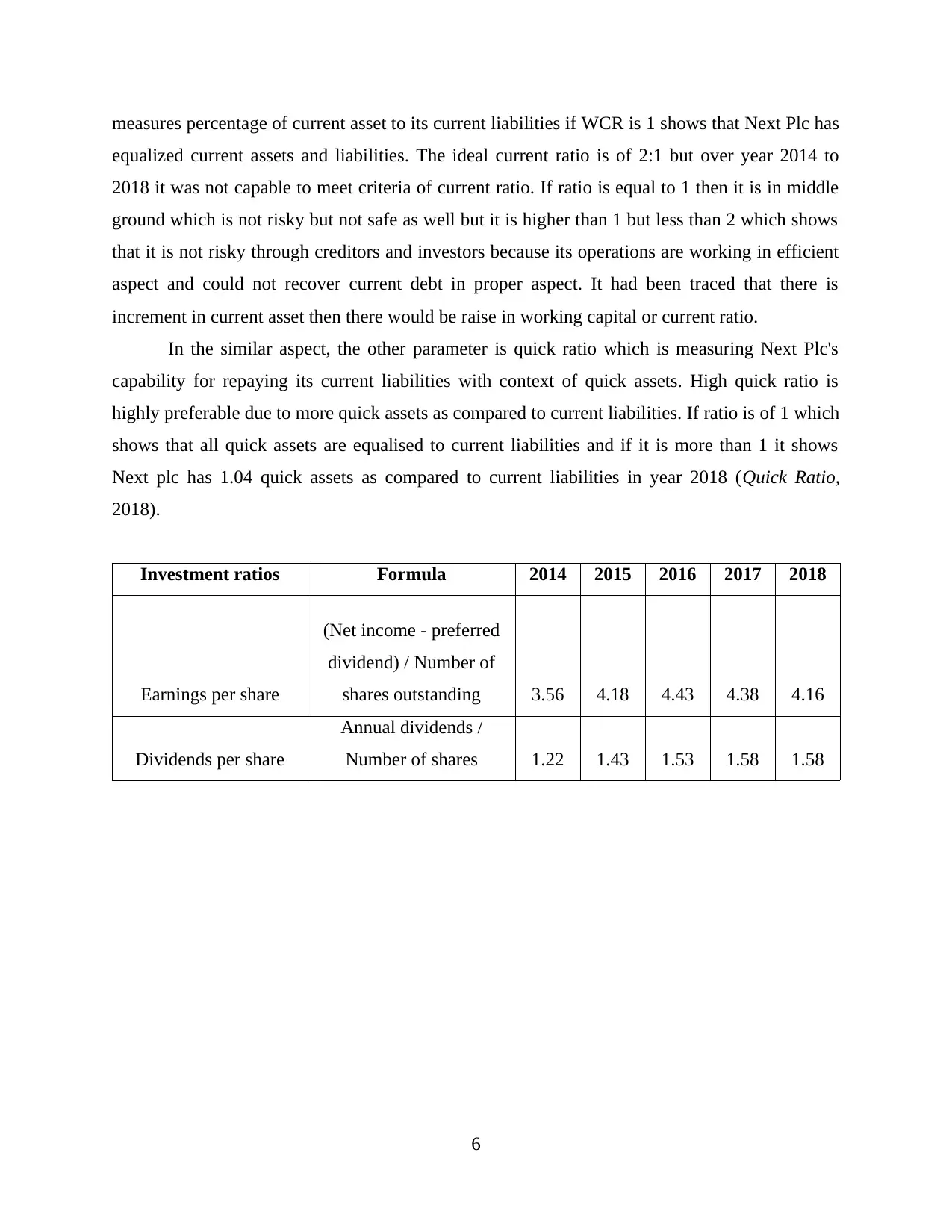
measures percentage of current asset to its current liabilities if WCR is 1 shows that Next Plc has
equalized current assets and liabilities. The ideal current ratio is of 2:1 but over year 2014 to
2018 it was not capable to meet criteria of current ratio. If ratio is equal to 1 then it is in middle
ground which is not risky but not safe as well but it is higher than 1 but less than 2 which shows
that it is not risky through creditors and investors because its operations are working in efficient
aspect and could not recover current debt in proper aspect. It had been traced that there is
increment in current asset then there would be raise in working capital or current ratio.
In the similar aspect, the other parameter is quick ratio which is measuring Next Plc's
capability for repaying its current liabilities with context of quick assets. High quick ratio is
highly preferable due to more quick assets as compared to current liabilities. If ratio is of 1 which
shows that all quick assets are equalised to current liabilities and if it is more than 1 it shows
Next plc has 1.04 quick assets as compared to current liabilities in year 2018 (Quick Ratio,
2018).
Investment ratios Formula 2014 2015 2016 2017 2018
Earnings per share
(Net income - preferred
dividend) / Number of
shares outstanding 3.56 4.18 4.43 4.38 4.16
Dividends per share
Annual dividends /
Number of shares 1.22 1.43 1.53 1.58 1.58
6
equalized current assets and liabilities. The ideal current ratio is of 2:1 but over year 2014 to
2018 it was not capable to meet criteria of current ratio. If ratio is equal to 1 then it is in middle
ground which is not risky but not safe as well but it is higher than 1 but less than 2 which shows
that it is not risky through creditors and investors because its operations are working in efficient
aspect and could not recover current debt in proper aspect. It had been traced that there is
increment in current asset then there would be raise in working capital or current ratio.
In the similar aspect, the other parameter is quick ratio which is measuring Next Plc's
capability for repaying its current liabilities with context of quick assets. High quick ratio is
highly preferable due to more quick assets as compared to current liabilities. If ratio is of 1 which
shows that all quick assets are equalised to current liabilities and if it is more than 1 it shows
Next plc has 1.04 quick assets as compared to current liabilities in year 2018 (Quick Ratio,
2018).
Investment ratios Formula 2014 2015 2016 2017 2018
Earnings per share
(Net income - preferred
dividend) / Number of
shares outstanding 3.56 4.18 4.43 4.38 4.16
Dividends per share
Annual dividends /
Number of shares 1.22 1.43 1.53 1.58 1.58
6
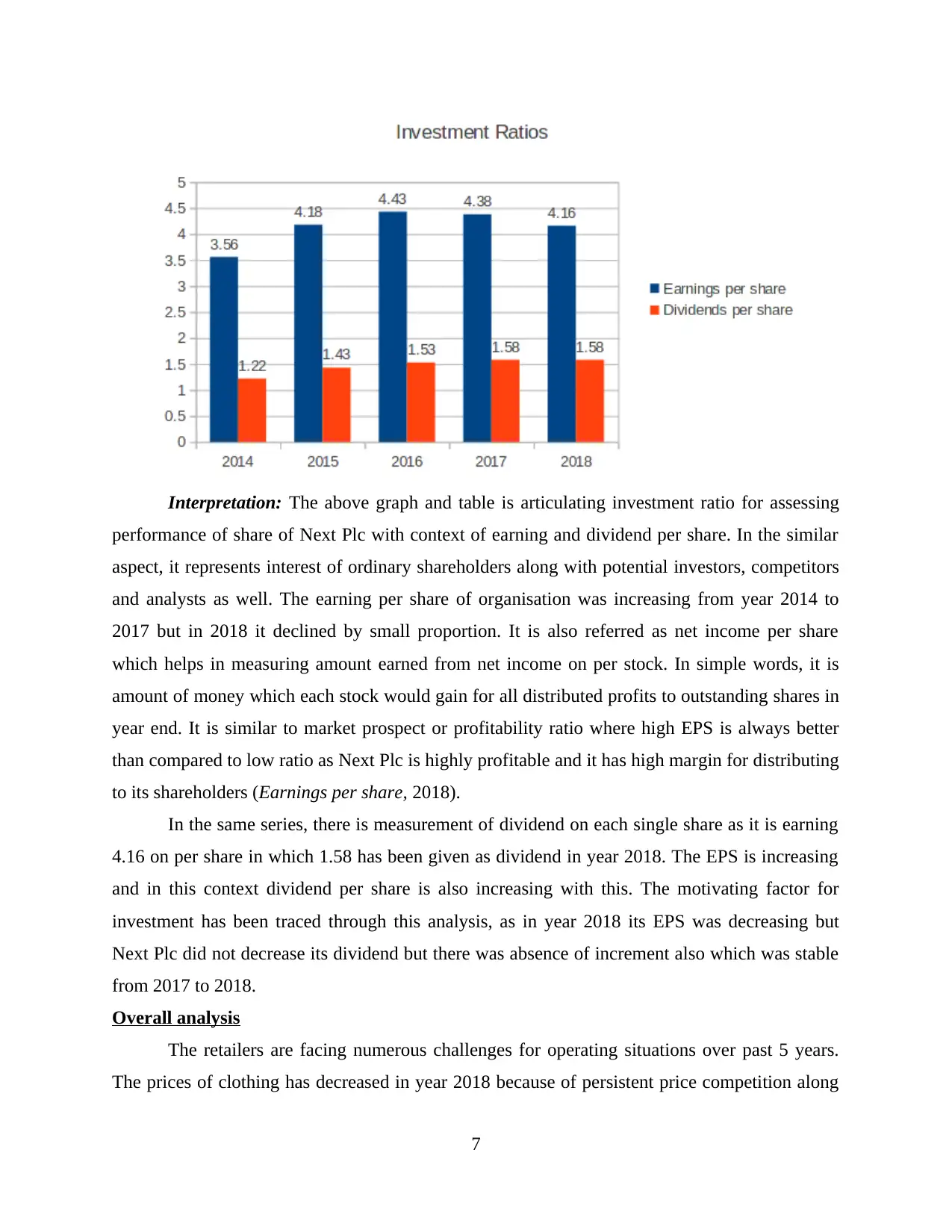
Interpretation: The above graph and table is articulating investment ratio for assessing
performance of share of Next Plc with context of earning and dividend per share. In the similar
aspect, it represents interest of ordinary shareholders along with potential investors, competitors
and analysts as well. The earning per share of organisation was increasing from year 2014 to
2017 but in 2018 it declined by small proportion. It is also referred as net income per share
which helps in measuring amount earned from net income on per stock. In simple words, it is
amount of money which each stock would gain for all distributed profits to outstanding shares in
year end. It is similar to market prospect or profitability ratio where high EPS is always better
than compared to low ratio as Next Plc is highly profitable and it has high margin for distributing
to its shareholders (Earnings per share, 2018).
In the same series, there is measurement of dividend on each single share as it is earning
4.16 on per share in which 1.58 has been given as dividend in year 2018. The EPS is increasing
and in this context dividend per share is also increasing with this. The motivating factor for
investment has been traced through this analysis, as in year 2018 its EPS was decreasing but
Next Plc did not decrease its dividend but there was absence of increment also which was stable
from 2017 to 2018.
Overall analysis
The retailers are facing numerous challenges for operating situations over past 5 years.
The prices of clothing has decreased in year 2018 because of persistent price competition along
7
performance of share of Next Plc with context of earning and dividend per share. In the similar
aspect, it represents interest of ordinary shareholders along with potential investors, competitors
and analysts as well. The earning per share of organisation was increasing from year 2014 to
2017 but in 2018 it declined by small proportion. It is also referred as net income per share
which helps in measuring amount earned from net income on per stock. In simple words, it is
amount of money which each stock would gain for all distributed profits to outstanding shares in
year end. It is similar to market prospect or profitability ratio where high EPS is always better
than compared to low ratio as Next Plc is highly profitable and it has high margin for distributing
to its shareholders (Earnings per share, 2018).
In the same series, there is measurement of dividend on each single share as it is earning
4.16 on per share in which 1.58 has been given as dividend in year 2018. The EPS is increasing
and in this context dividend per share is also increasing with this. The motivating factor for
investment has been traced through this analysis, as in year 2018 its EPS was decreasing but
Next Plc did not decrease its dividend but there was absence of increment also which was stable
from 2017 to 2018.
Overall analysis
The retailers are facing numerous challenges for operating situations over past 5 years.
The prices of clothing has decreased in year 2018 because of persistent price competition along
7
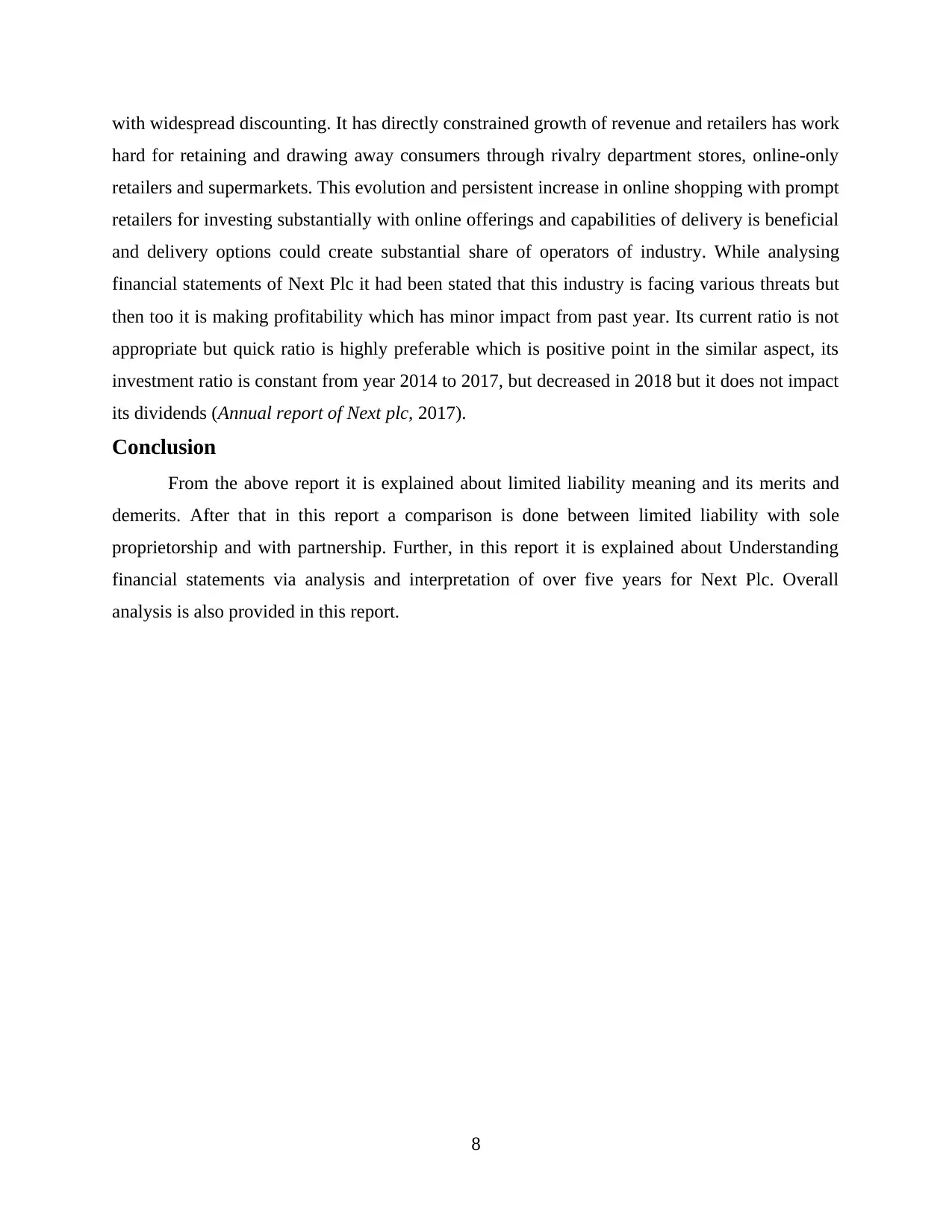
with widespread discounting. It has directly constrained growth of revenue and retailers has work
hard for retaining and drawing away consumers through rivalry department stores, online-only
retailers and supermarkets. This evolution and persistent increase in online shopping with prompt
retailers for investing substantially with online offerings and capabilities of delivery is beneficial
and delivery options could create substantial share of operators of industry. While analysing
financial statements of Next Plc it had been stated that this industry is facing various threats but
then too it is making profitability which has minor impact from past year. Its current ratio is not
appropriate but quick ratio is highly preferable which is positive point in the similar aspect, its
investment ratio is constant from year 2014 to 2017, but decreased in 2018 but it does not impact
its dividends (Annual report of Next plc, 2017).
Conclusion
From the above report it is explained about limited liability meaning and its merits and
demerits. After that in this report a comparison is done between limited liability with sole
proprietorship and with partnership. Further, in this report it is explained about Understanding
financial statements via analysis and interpretation of over five years for Next Plc. Overall
analysis is also provided in this report.
8
hard for retaining and drawing away consumers through rivalry department stores, online-only
retailers and supermarkets. This evolution and persistent increase in online shopping with prompt
retailers for investing substantially with online offerings and capabilities of delivery is beneficial
and delivery options could create substantial share of operators of industry. While analysing
financial statements of Next Plc it had been stated that this industry is facing various threats but
then too it is making profitability which has minor impact from past year. Its current ratio is not
appropriate but quick ratio is highly preferable which is positive point in the similar aspect, its
investment ratio is constant from year 2014 to 2017, but decreased in 2018 but it does not impact
its dividends (Annual report of Next plc, 2017).
Conclusion
From the above report it is explained about limited liability meaning and its merits and
demerits. After that in this report a comparison is done between limited liability with sole
proprietorship and with partnership. Further, in this report it is explained about Understanding
financial statements via analysis and interpretation of over five years for Next Plc. Overall
analysis is also provided in this report.
8
Paraphrase This Document
Need a fresh take? Get an instant paraphrase of this document with our AI Paraphraser
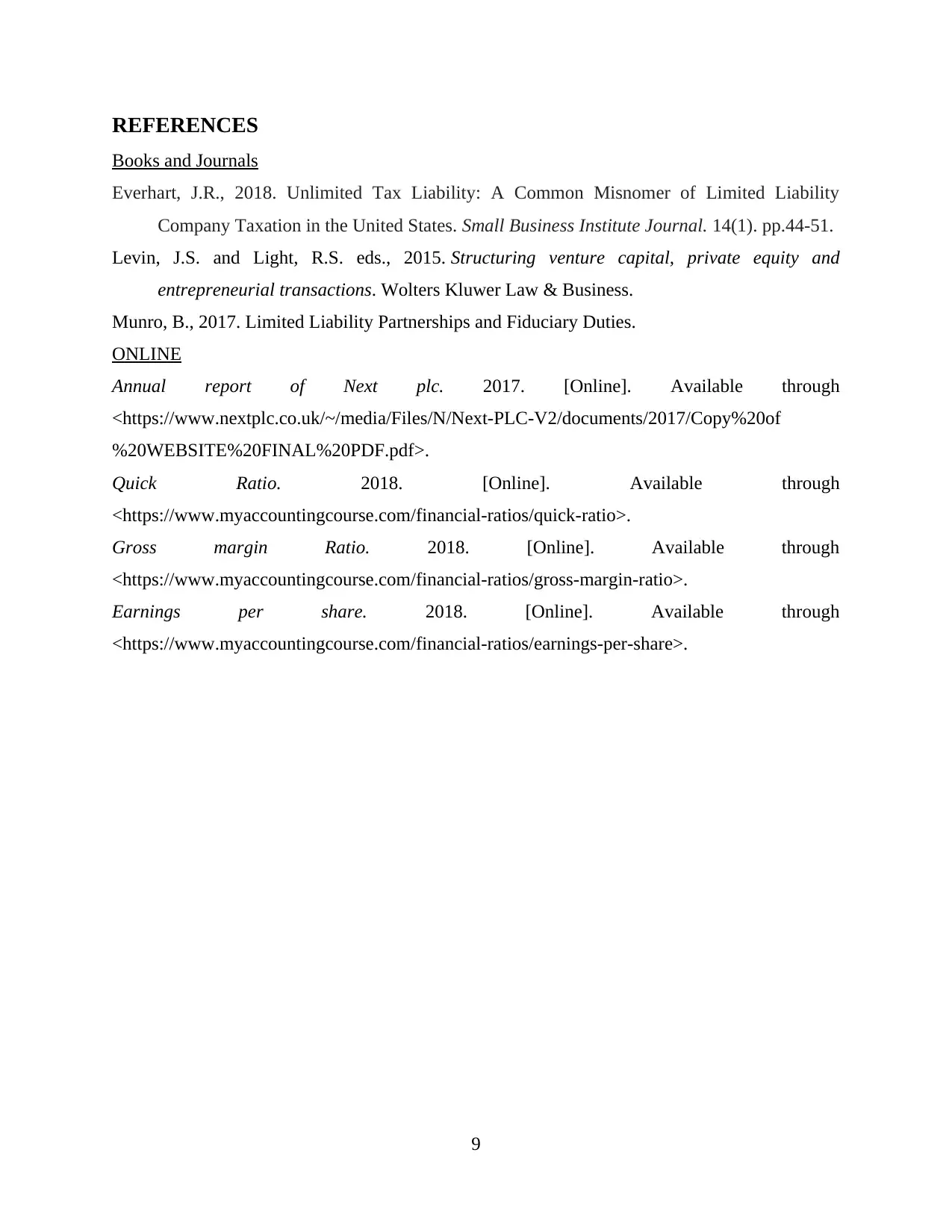
REFERENCES
Books and Journals
Everhart, J.R., 2018. Unlimited Tax Liability: A Common Misnomer of Limited Liability
Company Taxation in the United States. Small Business Institute Journal. 14(1). pp.44-51.
Levin, J.S. and Light, R.S. eds., 2015. Structuring venture capital, private equity and
entrepreneurial transactions. Wolters Kluwer Law & Business.
Munro, B., 2017. Limited Liability Partnerships and Fiduciary Duties.
ONLINE
Annual report of Next plc. 2017. [Online]. Available through
<https://www.nextplc.co.uk/~/media/Files/N/Next-PLC-V2/documents/2017/Copy%20of
%20WEBSITE%20FINAL%20PDF.pdf>.
Quick Ratio. 2018. [Online]. Available through
<https://www.myaccountingcourse.com/financial-ratios/quick-ratio>.
Gross margin Ratio. 2018. [Online]. Available through
<https://www.myaccountingcourse.com/financial-ratios/gross-margin-ratio>.
Earnings per share. 2018. [Online]. Available through
<https://www.myaccountingcourse.com/financial-ratios/earnings-per-share>.
9
Books and Journals
Everhart, J.R., 2018. Unlimited Tax Liability: A Common Misnomer of Limited Liability
Company Taxation in the United States. Small Business Institute Journal. 14(1). pp.44-51.
Levin, J.S. and Light, R.S. eds., 2015. Structuring venture capital, private equity and
entrepreneurial transactions. Wolters Kluwer Law & Business.
Munro, B., 2017. Limited Liability Partnerships and Fiduciary Duties.
ONLINE
Annual report of Next plc. 2017. [Online]. Available through
<https://www.nextplc.co.uk/~/media/Files/N/Next-PLC-V2/documents/2017/Copy%20of
%20WEBSITE%20FINAL%20PDF.pdf>.
Quick Ratio. 2018. [Online]. Available through
<https://www.myaccountingcourse.com/financial-ratios/quick-ratio>.
Gross margin Ratio. 2018. [Online]. Available through
<https://www.myaccountingcourse.com/financial-ratios/gross-margin-ratio>.
Earnings per share. 2018. [Online]. Available through
<https://www.myaccountingcourse.com/financial-ratios/earnings-per-share>.
9
1 out of 11
Related Documents
Your All-in-One AI-Powered Toolkit for Academic Success.
+13062052269
info@desklib.com
Available 24*7 on WhatsApp / Email
![[object Object]](/_next/static/media/star-bottom.7253800d.svg)
Unlock your academic potential
© 2024 | Zucol Services PVT LTD | All rights reserved.





